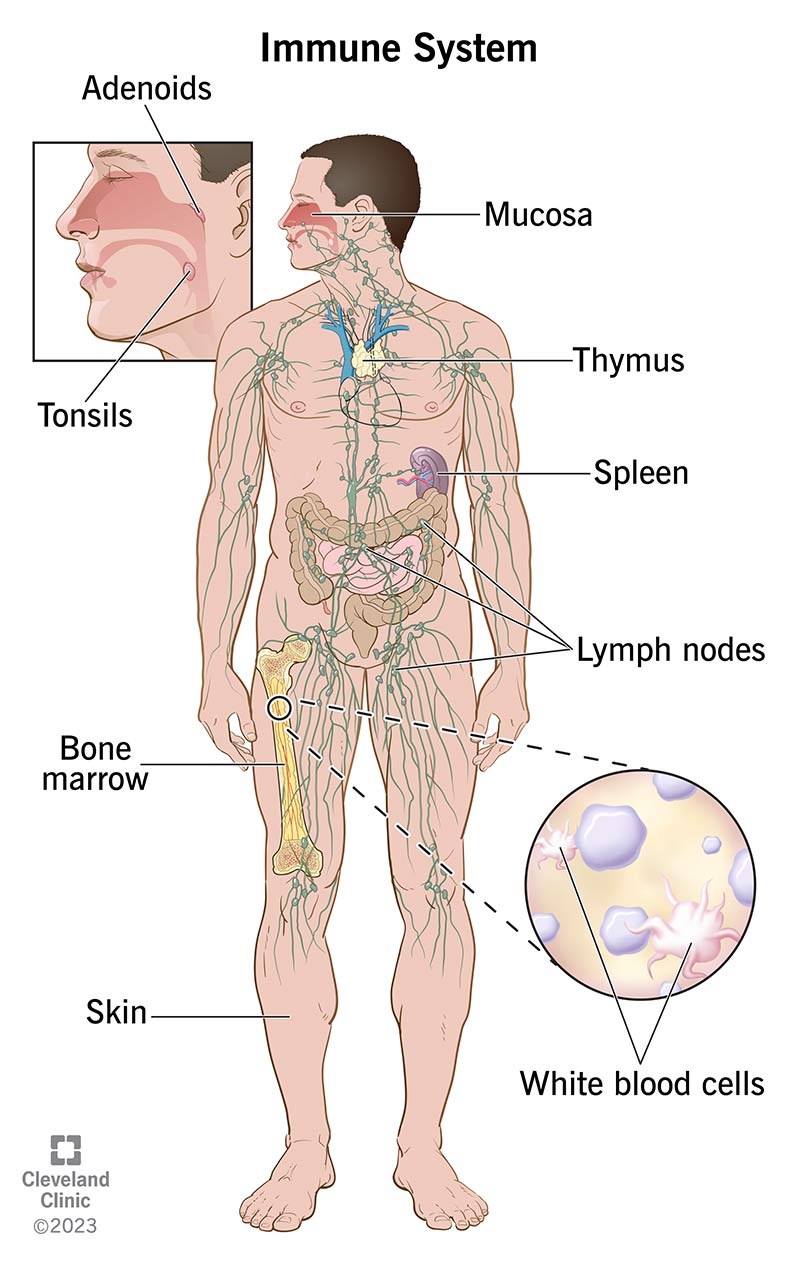Immune System Function, Conditions & Disorders

What parts of your body make up the immune system?
Many parts of your body, including immune system organs and cells, work together to keep you healthy. The main components of your immune system are:
- White blood cells. These immune system cells attack and eliminate harmful germs to keep you healthy. There are many types of white blood cells, and each type has a specific mission in your body’s defense system. Each type also has a different way of recognizing a problem, communicating with other cells and getting their job done.
- Antibodies. These proteins protect you from invaders by binding to them and initiating their destruction.
- Cytokines. These proteins serve as chemical messengers that tell your immune cells where to go and what to do. Different types of cytokines do different specific tasks, like regulating inflammation. Inflammation happens when your immune cells are warding off invaders or healing damage to your tissues.
- Complement system. This is a group of proteins that teams up with other cells in your body to defend against invaders and promote healing from an injury or infection.
- Lymph nodes. These small, bean-shaped organs are like colanders you use to drain pasta. They filter waste products from the fluid that drains from your tissues and cells (lymph) while keeping the good components, like nutrients. You have hundreds of lymph nodes throughout your body, and they’re a vital part of your lymphatic system.
- Spleen. This organ stores white blood cells that defend your body from invaders. It also filters your blood, recycling old and damaged cells to make new ones.
- Tonsils and adenoids. Located in your throat and nasal passage, tonsils and adenoids can trap invaders (like bacteria or viruses) as soon as they enter your body.
- Thymus. This small organ helps T-cells (a specific type of white blood cell) mature before they travel elsewhere in your body to protect you.
- Bone marrow. This soft, fatty tissue inside your bones is like a factory for your blood cells. It makes the blood cells your body needs to survive, including white blood cells that support your immune system.
- Skin. Your skin is a protective barrier that helps stop germs from entering your body. It produces oils and releases other protective immune system cells.
- Mucosa. This three-layered membrane lines cavities and organs throughout your body. It secretes mucus that captures invaders, like germs, for your body to then clear out.
Innate immunity vs. acquired immunity
Innate immunity is protection that you’re born with. Your innate immune system is part of your body’s first-line defense. It responds to invaders right away by attacking any organism that shouldn’t be in your body. It doesn’t need prior training to tell the difference between cells that belong in your body and those that don’t.
The white blood cells involved in innate immunity don’t learn to recognize certain invaders. They also have no memory of attacking invaders and don’t offer protection against specific germs (or the infections they cause) in the future.
That’s where acquired immunity comes into play. Acquired immunity, also called adaptive or specific immunity, is protection your body gains (acquires) over time from exposure to germs. Certain white blood cells called lymphocytes remember specific invaders and can tell when they don’t belong in your body. So, if those invaders try to get in again, the lymphocytes can quickly spring into action and work with other cells to eliminate the threat.
Vaccines support your acquired immunity by training its cells to identify and destroy invaders before they make you sick.
link






